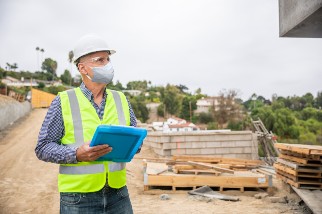Construction safety goes beyond protecting workers. You also have to protect the public. Construction projects happen in different environments, and you have to consider the people and property in those environments and how the work may impact them.
public. Construction projects happen in different environments, and you have to consider the people and property in those environments and how the work may impact them.
The recently updated ANSI/ASSP A10.34-2021 standard provides best practices for protecting the public on or adjacent to construction sites, and identifies different construction hazards that can endanger the people, property and environment surrounding the job site.
“It’s important to go out and actively perform a hazard assessment on and around your job site before work begins, and again periodically as new tasks occur,” says Shelly Pizzi, A10.34 subcommittee member. “Each project has a set of challenges that vary in terms of the type of public space, occupants and potential impacts to property.”
Pizzi says this hazard assessment is an effective tool for protecting the public from activity on the job site, and workers on the job site from intrusion by the public.
“The protective measures implemented during this assessment can work both ways because outside of the job site could be a child daycare, the busiest street in New York City or a polluted landfill,” she says. “Protection will look different for each job.”
This edition of A10.34 includes key updates that provide greater detail and clarity on how to protect the public on construction sites.
Greater Focus on Hazards
In updating the standard, the A10.34 subcommittee placed greater focus on certain construction hazards and provided additional guidance on how to properly address them to keep the public safe.
“In previous editions of the standard, the content focused heavily on the purpose and responsibility to protect people and property outside of the job site,” Pizzi explains. “More guidance was needed on two topics covering some of the most serious injuries in construction — falls/falling objects and run-over/back-over.
Sections on falls/falling objects and run-over/back-over were improved to include not only additional fall protection options for people and property below work activities, but also new requirements for tool tethering and greater detail on effective run-over/back over practices.
Other new sections address hazards and environments, including:
- Scaffolding
- Excavations
- Explosives
- Fire prevention
- Severe weather
- Utility avoidance
- Marine operations
Planning for Emergencies
The updated version also places greater emphasis on preparing an emergency action plan. A10.34 requires that measures be established to restrict public access to the job site.
“One of the most important considerations that applies specifically to the public is preparing an emergency action plan,” Pizzi explains. “The revised A10.34 standard moves this plan up to the front of the document as one of the first items to address when planning for public protection.”
An emergency action plan consists of four key elements:
- Security: Site management should enact measures to restrict public access to the job site. If this is not practical, site management should take steps should to lock, barricade or remove equipment, supplies or materials that pose a hazard.
- Injuries/Damage: Any observed injuries or damage to the public must be immediately assessed for severity and investigated, and immediate action to minimize further injury or damage and to secure medical help for those injured.
- Public Protest: The plan should define how the site will respond when members of the public purposely place themselves or others at risk by failing to observe or heed warnings, directives or safety precautions.
- Threats: The plan should also describe how to communicate bomb threats or other violence to the job site and include immediate notification to and interfacing with authorities.
“A myriad of things happen at once on construction sites, so having to stop and react to an incident is never desirable — especially if a person has been hurt,” she says. “It’s best to proactively attempt to eliminate or prepare for those unexpected events that can derail the project budget and schedule, or worse, injure a member of the public.”
A10.34-2021 provides a public hazard control plan template to help you identify hazards, describe the actions taken and assign responsibilities for reducing and eliminating the hazards identified.
The template includes examples of common hazards encountered over the course of a construction project, including noise, vibration, radiation and falling objects. You can also use this tool to identify those responsible for different aspects of the construction project, provide contact information for local utilities and emergency response authorities and list those authorized to access the job site after hours.
Download Appendix A Public Hazard Control Plan ANSI_ASSP_A10_34_2021 to use at your work sites.
Related Links
ANSI/ASSP A10.34, Protection of the Public on or Adjacent to Construction Sites
Three Steps to Controlling Hazardous Energy in Construction and Demolition
Managing Safety on Multiemployer Work Sites
Three Keys to Material Hoist Safety
OSHA Guidance for COVID-19 Prevention in Construction